Official Name:
Mbale is the name of the town where this meteorite shower fell.
Location:
The meteorites fell on and around the town of Mbale. Mbale is in eastern Uganda, which is in the central part of the African continent.
Fall or Find:
Fall
Date:
14 August 1992, 3:40 p.m., local time.
Mass Recovered:
About 150 kilograms of meteoritic matter were recovered. Researchers estimate that about 190 kilograms reached the Earth's surface.
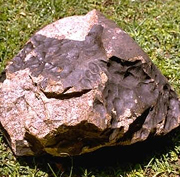
Enlargement
Main mass of the Mbale chondrite. This fragment was found at the front of the strewn field; it weighs 27.4 kilograms. |
|
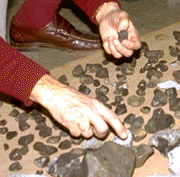
Enlargement
Researchers class hundreds of fragments of Mbale according to their mass. |
|
Number of Fragments:
Town residents and scientific expeditions collected a total of 863 stones in the year after the fall. The fragments vary in mass from 0.1 gram to 27.4 kilograms.
Strewn field:
The shower rained down on a densely populated area. The strewn field measured 7 kilometres by 3 kilometres.
Crater:
Depending on the type of soil they hit, some of the larger fragments created small depressions. Only one of these depressions was larger than one metre in diameter.
Circumstances:
The meteoroid began to break apart at an altitude of 25 kilometres. The fragmentation ended at an altitude somewhere between 10 and 14 kilometres. A loud explosion was then heard, followed by a low rumbling. A trail of greyish smoke and a cloud of dust were seen in the sky for several minutes. Fragments of the meteorite struck several buildings, but nobody was hurt. One stone landed on a boy's head, but luckily he was not harmed-the fragment weighed only 3.6 grams, and the leaves of a banana tree slowed its fall. The final stage of the shower was accompanied by sounds that resembled gunshots.
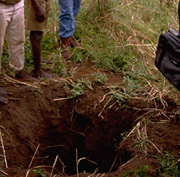
Enlargement
The Ugandan boy showing the meteorite that landed on his head. |
|
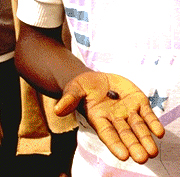
Enlargement
Depression created by one of the fragments from the meteorite. |
|
History:
In modern history, meteorites have only hit two people. The Ugandan boy from Mbale is the second authenticated case.
Type:
Stony meteorite
Class:
Ordinary chondrite
Group:
L5/6
Composition:
The largest fragments are angular. Except for fragments broken after their discovery, all have a fusion crust.
Olivine is the main constituent of the Mbale chondrite, followed by pyroxene. Nickel-iron inclusions make up between 15 and 20% of the meteorite's volume. The chondrules vary in size from 0.4 to 1 millimetre-most of them are indistinct and deformed. They are imprisoned in a fine grey matrix. Glossy black veins cover the meteorite.
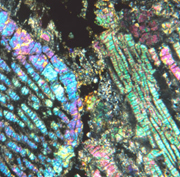
Enlargement
An irregular chondrule from Mbale, seen in polarized light. |
|
Scientific contribution:
Studying the distribution of meteorites in a strewn field provides information about the meteoroid's trajectory and fragmentation process. Scientists have estimated that the mass of the Mbale meteoroid was about 1 000 kilograms before it entered the atmosphere. The most-distant point of its orbit was in the outer region of the asteroid belt.
Comments:
Some villagers believed that the meteorite fragments were a remedy sent by God. The crust from certain stones was crushed and then ingested or applied to injuries.
Part of the Planétarium's collection:
Yes